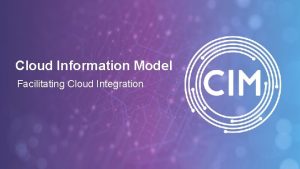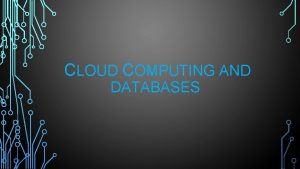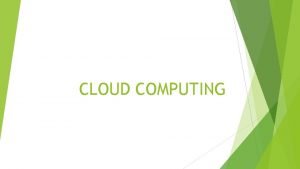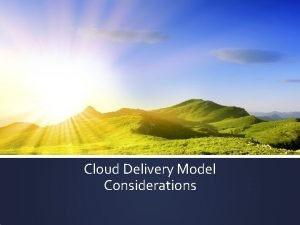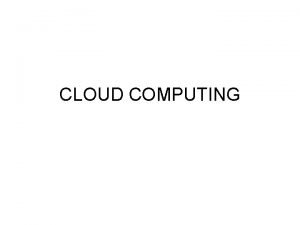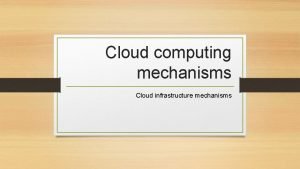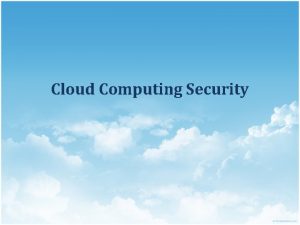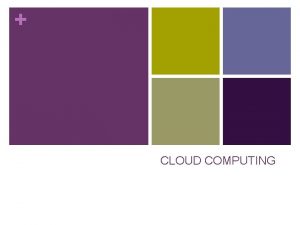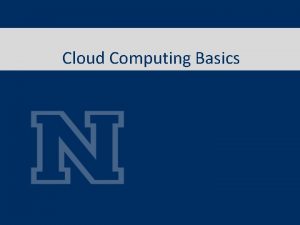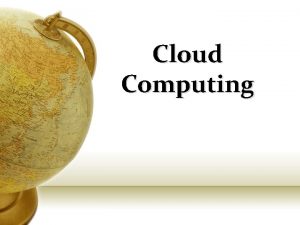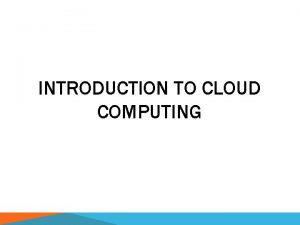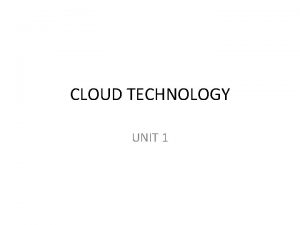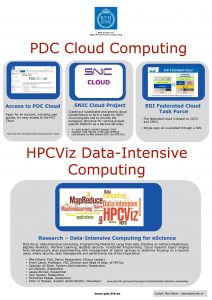INFORMATION ECONOMY REPORT 2013 The Cloud Economy and



























- Slides: 27

INFORMATION ECONOMY REPORT 2013 The Cloud Economy and Developing Countries Torbjörn Fredriksson (torbjorn. fredriksson@unctad. org) Chief, ICT Analysis Section, UNCTAD 28 April 2014, Tunis, Second SG 13 Regional ITU Workshop for Africa on "Future Networks: Cloud Computing, Energy Saving, Security, and Virtualization“

Introduction to UNCTAD United Nations Conference on Trade and Development Founded in 1964 Overall aim: to promote the development-friendly integration of developing countries into the world economy. Focus areas: o o o International trade and commodities ICTs Investment and enterprise development Commodities Technology and logistics Africa and the least developed countries 2

UNCTAD and ICT Collaboration with ITU and other UN agencies UN Group on the Information Society (UNGIS) o Chairs and vice chairs: ITU, UNCTAD, UNESCO, UNDP and UNDESA o 30 members Co-organizer of the annual WSIS Forum/WSIS+10 HL Event o Lead facilitator of Action Line C 7 on E-business o High Level Event: 10 -13 June 2014 Secretariat of the CSTD o Follow-up to the WSIS – next session 12 -16 May 2014 Partnership on Measuring ICT for Development o Member of its Steering Committee o 13 members 3

IER 2013 The Cloud Economy and Developing Countries q Early stage but of growing relevance q Need for objective analysis q Lack of evidence q Valuable input from ITU Study Group, Jamil Chawki q First cloud analysis by UN secretariat

What is Cloud Computing? A way of delivering applications, services or content remotely, rather than requiring users to hold them on their own servers, computers or other devices. o Cloud computing is a model for enabling ubiquitous, convenient, on-demand network access to a shared pool of configurable computing resources (e. g. , networks, servers, storage, applications, and services) that can be rapidly provisioned and released with minimal management effort or service provider interaction. (NIST, 2011) Webmail, online social networks and file-sharing among the most popular applications on the Internet, also in the developing world. Metaphor of the "cloud" misleading – cloud is enabled by physical hardware, networks, storage, services and

The Cloud Economy – a Framework Key stakeholders and market relationships Source: UNCTAD.

What has enabled the Cloud? Processing power o Intel’s current 22 nanometre CPU is 4, 000 times faster, uses 0. 02 per cent of the energy and costs 1/50, 000 of its first CPU released in 1971 Digital storage o The first IBM PC (1981) cost $3, 000; accepted diskettes of 160 kb o By 2010, a hard disk for $600 could store all music ever recorded Transmission speed o Dial-up connection in 1993: 56 kbps o As of 2013, some consumer broadband packages 2 Gbps – some 36, 000 times faster

Cloud computing characteristics and models Source: UNCTAD, adapted from NIST 2011.

Cloud revenue estimates and forecasts vary 2010 and 2015, $ billions 2010 Forecast by: Gartner Forrester 2015 Saa. S Paas Iaas Total 10. 0 (70. 9%) 1. 3 (9. 2%) 2. 8 (19. 9%) 14. 1 (100. 0%) 21. 3 (49. 2%) 2. 4 (5. 5%) 19. 6 (45. 3%) 43. 3 (100. 0%) 13. 4 (91. 1%) 0. 3 (2. 2%) 1. 0 (6. 7%) 14. 7 (100. 0%) 78. 4 (83. 5%) 9. 8 (10. 4%) 5. 8 (6. 1%) 94. 1 (100. 0%) These numbers do not include advertising revenue! Source: Berry and Reisman, 2012: 6.

Cloud-related traffic on the Internet Mainly in developed countries but growing fast Source: Cisco Analysis.

Top Global Cloud Companies by estimated number of servers 2012 Company Google Microsoft Amazon Web Services Facebook Akamai OVH Softlayer Rackspace (2011) Intel 1&1 Home country United States United States France United States Estimated number of servers 900, 000 300, 000 250, 000 180, 000 127, 000 120, 000 100, 000 79, 805 75, 000 70, 000 Source: UNCTAD, based on information from company reports and other sources.

Pros and cons with the Cloud Potential advantages Potential disadvantages Reduced costs for rented IT hardware and software than for in-house equipment. Reduced cost of in-house IT management Enhanced elasticity of storage/processing capacity Increased costs of communications (to telecom operators/ISPs) Greater flexibility and mobility of access to data and services Immediate and cost-free upgrading of software Enhanced reliability/security of data and services Data security and privacy concerns Source: UNCTAD. Increased costs for migration and integration Reduced control over data and applications Unreliable services, e. g. due to inadequate ICT or power infrastructure Risk of vendor lock-in (limited interoperability and data portability) with providers

The Broadband Challenge Gap to LDCs keep widening Fixed broadband subscriptions per 100 people, 2007 -2012 Africa (2012): 1 Source: ITU. Active mobile broadband subscriptions per 100 people, 2010 -2012 Africa (2012): 6

The Data Centre and Server Divides Source: Data. Centre. Map and World Bank.

The Internet Exchange Point (IXP) Divide Distribution (%) of IXPs by region, June 2013 q Issue recognized by African Union Commission through the African Internet Exchange System project, funded by the EU-Africa Infrastructure Trust Fund and the Government of Luxembourg. q Studies of IXPs in Kenya and Nigeria show significant reduction in latency Source: Packet Clearing House.

“Quality of Service” requirements vary Latency and upload speeds main bottlenecks for developing countries. Source: Cisco Analysis.

Broadband Quality of Service – Africa Meet minimum requirements for advanced cloud services Meet minimum requirements for basic cloud services Do not yet meet requirements for basic cloud services Egypt Ghana Kenya Morocco South Africa Tunisia Algeria Angola Côte d'Ivoire Mauritius Mozambique Namibia Nigeria Senegal Sudan Uganda United Republic of Tanzania Zambia Zimbabwe Source: UNCTAD, based on Cisco Analysis 2012.

Regulatory issues Cloud data can become subject to multiple jurisdictions The transfer of data out of the user’s jurisdiction may raise issues of control, effective oversight and audit. For some regulated sectors, such as financial services, cloud-related transfers and storage outside the jurisdiction may breach national rules. Key legal areas to address: o Data protection o Privacy o Cybercrime Source: UNCTAD.

Standardization issues Cloud computing new and evolving area Cloud service providers offer different approaches, based on different business models, capabilities and customer profiles Standards critical to achieve interoperability, spur competition and enable effective use of multiple providers Standard-setting activities on cloud mainly in and by developed countries – risk that specific needs and requirements of developing countries are not adequately addressed Source: UNCTAD.

Policy recommendations Welcome the cloud economy but tread carefully Assess “cloud readiness“, define national strategy with relevant partners Consider all cloud relevant configurations Enhance access to reliable, affordable broadband Address relevant laws and regulations Recognize supply side opportunities of the cloud economy Consider Government's own use of the cloud Engage in standardisation forums Seek support from Development Partners

Supply-side cloud opportunities in developing countries Data centre services o Local and foreign providers o Government-owned centres Provision of cloud services for local customers o Infrastructure as a Service (Iaa. S) –first step in low-income countries o Platform as a Service (Paa. S) o Software as a Service (Saa. S) Cloud aggregation, system integration, brokerage and related services o Leverage experience with national business, legal and communications environment.

Data centre developments in Africa some examples Communications providers o Galaxy Backbone and Globacom (Nigeria) o Safaricom (Kenya) Government projects o Kenya: data centre capacity for its own use as well as for public access to reduce costs for businesses and organizations that need to host data in-country. o Ghana: three data centres that will host data from all government ministries, departments and agencies.

Cloud services in Africa – some examples MTN (South Africa) launched cloud service business packages for SMEs in Ghana and Nigeria in December 2012 Vodacom, a South African telecommunication operator has partnered with Novell, an IT provider, to offer cloud services Pamoja Cloud Services, owned by SEACOM (South Africa) targets demand for IT-as-a-Service from SMEs in Africa Cloud aggregation services companies in Nigeria: Computer Warehouse, Resourcery, City Business Computers and Computer Information System Mothers-2 -mothers (M 2 M), a South African NGO, combines the cloud with database technology and mobile services to reduce the incidence of HIV/AIDS transmission from mothers to children

Policy recommendations Welcome the cloud economy but tread carefully Assess “cloud readiness“ and define national cloud strategy with relevant stakeholders Consider all cloud configurations: public/private/hybrid clouds implemented nationally, regionally or globally Enhance access to reliable, affordable broadband Address laws and regulations concerning privacy, data protection and cybercrime Recognize supply side opportunities of the cloud economy Consider Government's own use of the cloud Seek support from Development Partners

THE INFORMATION ECONOMY REPORT 2013 can be downloaded free of charge at unctad. org/ier

Getting to the cloud Source: UNCTAD.

Areas and bodies for cloud computing standardisation Source: Standardisation activities for cloud computing, NTT
 Athenian economy vs sparta economy
Athenian economy vs sparta economy Opportunities of media and information in economic
Opportunities of media and information in economic Seven step model of migration into cloud
Seven step model of migration into cloud Cloud integration patterns
Cloud integration patterns Public cloud vs private cloud cost analysis
Public cloud vs private cloud cost analysis Snapcloud
Snapcloud Writing a status report
Writing a status report Cloud readiness assessment report
Cloud readiness assessment report Information rules a strategic guide to the network economy
Information rules a strategic guide to the network economy Hát kết hợp bộ gõ cơ thể
Hát kết hợp bộ gõ cơ thể Bổ thể
Bổ thể Tỉ lệ cơ thể trẻ em
Tỉ lệ cơ thể trẻ em Voi kéo gỗ như thế nào
Voi kéo gỗ như thế nào Tư thế worm breton là gì
Tư thế worm breton là gì Chúa sống lại
Chúa sống lại Môn thể thao bắt đầu bằng từ đua
Môn thể thao bắt đầu bằng từ đua Thế nào là hệ số cao nhất
Thế nào là hệ số cao nhất Các châu lục và đại dương trên thế giới
Các châu lục và đại dương trên thế giới Công thức tiính động năng
Công thức tiính động năng Trời xanh đây là của chúng ta thể thơ
Trời xanh đây là của chúng ta thể thơ Cách giải mật thư tọa độ
Cách giải mật thư tọa độ Làm thế nào để 102-1=99
Làm thế nào để 102-1=99 độ dài liên kết
độ dài liên kết Các châu lục và đại dương trên thế giới
Các châu lục và đại dương trên thế giới Thơ thất ngôn tứ tuyệt đường luật
Thơ thất ngôn tứ tuyệt đường luật Quá trình desamine hóa có thể tạo ra
Quá trình desamine hóa có thể tạo ra Một số thể thơ truyền thống
Một số thể thơ truyền thống



























